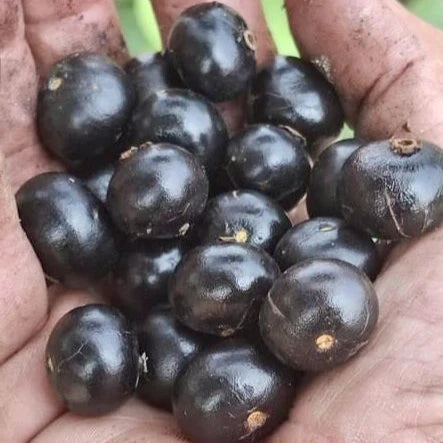Love it? Add to your wishlist
Your favorites, all in one place. Shop quickly and easily with the wishlist feature!
[message]
[title]
[message]



Veliyath Gardens
Couldn't load pickup availability
Common Name: Pitanga de Cachorro
Botanical Name: Neomitranthes obscura
Among the lesser-known treasures of Brazil’s Atlantic coastal regions lies a small, charming fruit tree known locally as Pitanga de Cachorro. Scientifically named Neomitranthes obscura, this compact evergreen species originates from the lush, humid zones of São Paulo and Rio de Janeiro. Revered for its modest size, tidy growth, and attractive fruits, it has quickly become a favorite among collectors of rare tropical edibles.
The tree's graceful form and compact canopy make it an ideal candidate for urban gardening, particularly in balconies, patios, courtyards, and even indoor conservatories. But beyond its ornamental charm, it also yields a refreshing fruit that carries both culinary value and natural health benefits.
At first glance, the fruits resemble miniature jaboticabas—small, round, and often deep purple when ripe. However, Pitanga de Cachorro has its own signature flavor and textural identity:
Shape & Size: Round to slightly oval; roughly 1–2 cm in diameter
Color: Deep wine to black-purple when fully ripe
Taste Profile: Sweet with a faint astringency that provides a refreshing balance
Texture: Juicy and tender with edible skin and soft pulp
Fragrance: Light, earthy, and subtly floral when freshly harvested
It’s a fruit that offers both palate interest and hydration, making it ideal for snacking during hot afternoons or for adding a lively twist to homemade recipes.
While in Brazil, the plant is fondly known as Pitanga de Cachorro, it is still relatively unknown outside of its native habitat. In select gardening and botany communities in Europe and Southeast Asia, it is referred to by its botanical name or simply “miniature jaboticaba.” As it gains traction among exotic fruit enthusiasts in India and Thailand, it is becoming one of the must-have tropical species for compact gardens.
Despite its small size, the fruit is nutritionally rich and contributes to overall wellness in several ways:
Antioxidants – Protects the body from oxidative stress, aging, and inflammation
Vitamin C – Supports immune function and collagen production
Fiber – Aids digestion and gut health
Polyphenols – May improve cardiovascular function and reduce cholesterol
Low Glycemic – Ideal for mindful snacking and diabetic-conscious diets
Regular consumption of this fruit, even in modest quantities, supports natural detoxification and adds plant-based nutrients to the diet.
In its native region, the fruit is eaten fresh, directly off the branch. The light astringency actually makes it more refreshing, especially in warm climates. In home kitchens, it is also used to:
Prepare small-batch jams and jellies
Add color and nutrition to smoothies and juices
Serve as a garnish in tropical fruit salads
Use as a topping for desserts like yogurt, panna cotta, or ice cream
Its flavor intensifies with slight chilling, making it a perfect refrigerator fruit during peak season.
One of the plant’s most impressive features is its adaptability and ease of care, especially for hobby gardeners or those new to tropical fruit plants.
Plant Type: Evergreen shrub or small tree
Height: Usually grows between 1.5 to 3 meters
Growth Rate: Fast, especially in warm, humid climates
Light: Prefers partial to full sunlight
Watering: Regular watering; thrives in moist but well-drained soil
Soil Preference: Slightly acidic, organic-rich soil
Bloom and Fruiting Time: Begins producing fruits in 2–3 years
Pest/Disease Resistance: Naturally resilient in most conditions
It’s a low-maintenance plant, perfect for container cultivation, and performs beautifully when pruned annually to maintain shape and airflow.
Although it hasn't yet entered mainstream agricultural production, Neomitranthes obscura holds cultural value as a native Brazilian species that supports biodiversity and traditional foraging habits. It represents a broader movement to rescue lesser-known plants from obscurity and promote genetic diversity in fruit cultivation.
In recent years, collectors and eco-conscious gardeners have made efforts to preserve and propagate this plant, recognizing its ecological and nutritional importance. Veliyath Gardens stands at the forefront of this initiative in India.
At Veliyath Gardens, our mission is to bring unique, healthy, and culturally rich plants from across the globe into the hands of conscious growers and enthusiasts. Our introduction of Pitanga de Cachorro is part of a larger educational initiative, aiming to turn gardens into living libraries of edible biodiversity.
We believe that each plant has a story worth sharing, and Neomitranthes obscura is a storyteller in its own right—of Brazilian forests, of native flavors, and of ecological importance.
Due to its slow propagation cycle and high collector demand, availability of this plant remains limited at Veliyath Garden, and we encourage early inquiries for those wishing to add this delightful fruit to their collections.
Whether you’re a home gardener, a culinary explorer, or a collector of rare plants, Pitanga de Cachorro offers a new experience with every fruiting season. Its blend of manageable size, rewarding harvests, and health benefits makes it more than just a fruit tree—it becomes a conversation piece, a seasonal favorite, and a gift to your garden’s ecosystem.
Plant this beauty from Veliyath Gardens, and take part in a growing movement that honors taste, tradition, and natural wellness—all in one pot.
Height: Usually grows between 1.5 to 3 meters
Growth Rate: Fast, especially in warm, humid climates
Light: Prefers partial to full sunlight
Watering: Regular watering; thrives in moist but well-drained soil
Antioxidants – Protects the body from oxidative stress, aging, and inflammation
Vitamin C – Supports immune function and collagen production
Fiber – Aids digestion and gut health
Prepare small-batch jams and jellies
Add color and nutrition to smoothies and juices
Serve as a garnish in tropical fruit salads




